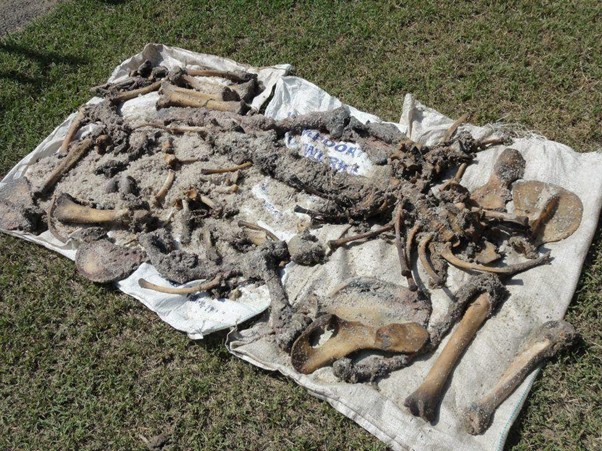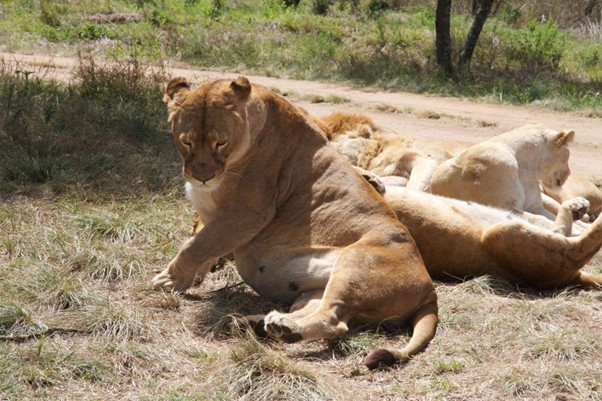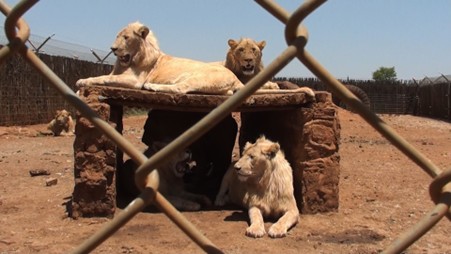Study: Commercial Lion Farming in South Africa Could Be Harming, Not Helping, Wild Lions
I recently co-authored a new peer-reviewed study that has delivered another blow to South Africa’s controversial commercial captive lion industry, finding no solid evidence that breeding lions in captivity benefits wild populations and warning that it may be doing the opposite. Our study, a collaboration with researchers from Blood Lions and World Animal Protection, paints a troubling picture of an industry that has exploded over the past three decades to around 350 facilities holding nearly 8,000 lions — alongside thousands of other big cats — for exhibition and breeding, tourism experiences, “canned” or captive trophy hunting, and the trade in bones and body parts. We examined 126 scientific papers and 37 organizational reports published between 2008 and 2023, flagging three major concerns: Currently there is no proof that the commercial industry aids conservation. Captive breeding may increase demand for lion parts. Links between legal and illegal trade could be strengthened. Bottle feeding and cub petting are popular revenue streams for captive predator facilities. Cubs are separated from their mothers at a young age, forcing the females back into estrus while visitors pay to interact with the cubs. © Blood Lions, used with permission. From cub-petting selfies to walking with lions, “canned” hunts, and the (now illegal) export of lion skeletons, the commercial predator industry is big business. The industry claims that commercial lion farming relieves pressure on wild lions; our study shows that it could actually fuel the demand for lion products and open the door to increased wildlife trafficking. Can Commercial Breeding Meet Consumer Demand? While proponents of commercial wildlife utilization assert that wildlife farming offers an effective means to meet the demand for wildlife commodities and relieve pressure on wild populations, our analysis of previous work by researchers and conservationists shows that this approach may be counterproductive. Farming wildlife may, in fact, put increased pressure on wild populations by promoting demand for wildlife products. This increases the risk of wildlife poaching and laundering through existing legal channels. It has also been noted that captive wildlife stock is sometimes renewed with animals from the wild to bring in fresh genes and prevent inbreeding or to breed for specific traits, such as dark manes. Countering arguments that farming wild animals is a logical means to protect wild populations, conservationists and researchers have highlighted that such mistaken assumptions may endanger wild populations. Other species have already demonstrated that commercial farming of wild species — such as tigers for bones and other body parts, bears for bile, and Southeast Asian porcupines for meat consumption — have all put increased pressure on wild populations. Consumer demand studies that have highlighted a preference for products sourced from wild-caught animals based on perceptions of medicinal strength or meat quality. Overall these studies highlight the faulty logic inherent in justifying the commercial breeding of wild animals as a supply-side approach. A lion skeleton prepared for export to be used in Traditional Chinese Medicine and trinkets. © Blood Lions, used with permission. There’s still a lot we don’t know. In our paper we highlighted the urgent need for scientific, peer-reviewed research to better understand consumer demand, economic comparisons between wild and farmed products, the genetics of captive lions, and the scale of illicit trade to get a more complete picture of the impact of commercial lion farming on wild lions. South African Wild Lion Populations Remain Stable, But What About Other Range States? In 2018 an assessment for African lions stated that the export of captive-bred lion trophies, live captive-bred lions for zoological or breeding purposes, and/or the trade of lion skeletons from the captive population would not harm South Africa’s wild lion population. The commercial captive lion industry has repeatedly failed to account for severe welfare issues, including malnourishment, obesity, overbreeding, inbreeding, poor keeping conditions, and health concerns. © Blood Lions, used with permission. But while wild lion populations in South Africa remain stable, our new research clearly highlights the risks associated with a commercial captive lion industry and the already vulnerable wild lion populations and other big cat species across other range states. Dr. Louise de Waal, director of Blood Lions and one of the paper’s authors, says South Africa’s stable wild lion population could change if the captive industry keeps growing: “We need to err on the side of caution globally, but in particular in African lion range states, to stop facilitating further emergence of commercial captive predator breeding and trade. This is particularly relevant when considering the increased wildlife trafficking opportunities between the African continent and Southeast Asia through, for example, the expansion of the Belt and Road Initiative, a global infrastructure development strategy by the Chinese government.” Welfare Concerns Continue The industry also has a long record of animal welfare violations. Some of the most recent cases include a successful conviction for animal cruelty after starved lions were discovered at a farm in May 2023. In another National Council of Societies for the Prevention of Cruelty to Animals (NSPCA) welfare case in 2025, horrific animal cruelty and neglect were uncovered at a notorious predator facility, where at least 80 tigers were kept for commercial purposes, one of whom had resorted to self-mutilation to relieve stress and pain from untreated injuries. Commercial captive-keeping conditions fail to provide adequate living conditions for sentient apex predators, including the ability to hunt and roam freely. © Blood Lions, used with permission. These aren’t isolated incidents. Douglas Wolhuter, national chief inspector and manager of the NSPCA Wildlife Protection Unit, reported that they had conducted 176 inspections of captive lion facilities across South Africa from 2022 to 2024. Wolhuter outlined that in most cases, captive predators were denied even the bare basics like access to clean drinking water, proper food, shelter, environmental enrichment, hygienic living conditions, and appropriate veterinary care, including treatment of parasitic infestations. Many of the captive predator- and lion-breeding facilities required repeat visits due to unaddressed noncompliances. Their inspections resulted in 64 warnings, 10 formal Animal Welfare Notices, and 21 warrants granted in 2022 alone. That year, as a result, 23 severely compromised lions had to be euthanized. Our research, combined with these on-the-ground realities, provides another catalyst for South Africa’s Minister of Forestry, Fisheries, and the Environment, Dr. Dion George, to take urgent action by implementing a moratorium on breeding and a time-bound phaseout plan. It also signals the serious need for caution: Lion farming in South Africa isn’t saving wild lions. It could even be accelerating their decline, particularly in already vulnerable lion range states across other African countries. Previously in The Revelator: In South Africa, Tigers and Other Captive Predators Are Still Exploited for Profit. Legislation Offers Pitiful Protection The post Study: Commercial Lion Farming in South Africa Could Be Harming, Not Helping, Wild Lions appeared first on The Revelator.
As we’ve seen with tigers and other threatened species, captive lion breeding may stimulate consumer demand and put additional pressure on wild populations across African home ranges. The post Study: Commercial Lion Farming in South Africa Could Be Harming, Not Helping, Wild Lions appeared first on The Revelator.
I recently co-authored a new peer-reviewed study that has delivered another blow to South Africa’s controversial commercial captive lion industry, finding no solid evidence that breeding lions in captivity benefits wild populations and warning that it may be doing the opposite.
Our study, a collaboration with researchers from Blood Lions and World Animal Protection, paints a troubling picture of an industry that has exploded over the past three decades to around 350 facilities holding nearly 8,000 lions — alongside thousands of other big cats — for exhibition and breeding, tourism experiences, “canned” or captive trophy hunting, and the trade in bones and body parts.
We examined 126 scientific papers and 37 organizational reports published between 2008 and 2023, flagging three major concerns:
-
- Currently there is no proof that the commercial industry aids conservation.
- Captive breeding may increase demand for lion parts.
- Links between legal and illegal trade could be strengthened.

From cub-petting selfies to walking with lions, “canned” hunts, and the (now illegal) export of lion skeletons, the commercial predator industry is big business. The industry claims that commercial lion farming relieves pressure on wild lions; our study shows that it could actually fuel the demand for lion products and open the door to increased wildlife trafficking.
Can Commercial Breeding Meet Consumer Demand?
While proponents of commercial wildlife utilization assert that wildlife farming offers an effective means to meet the demand for wildlife commodities and relieve pressure on wild populations, our analysis of previous work by researchers and conservationists shows that this approach may be counterproductive.
Farming wildlife may, in fact, put increased pressure on wild populations by promoting demand for wildlife products. This increases the risk of wildlife poaching and laundering through existing legal channels.
It has also been noted that captive wildlife stock is sometimes renewed with animals from the wild to bring in fresh genes and prevent inbreeding or to breed for specific traits, such as dark manes.
Countering arguments that farming wild animals is a logical means to protect wild populations, conservationists and researchers have highlighted that such mistaken assumptions may endanger wild populations.
Other species have already demonstrated that commercial farming of wild species — such as tigers for bones and other body parts, bears for bile, and Southeast Asian porcupines for meat consumption — have all put increased pressure on wild populations. Consumer demand studies that have highlighted a preference for products sourced from wild-caught animals based on perceptions of medicinal strength or meat quality. Overall these studies highlight the faulty logic inherent in justifying the commercial breeding of wild animals as a supply-side approach.

There’s still a lot we don’t know. In our paper we highlighted the urgent need for scientific, peer-reviewed research to better understand consumer demand, economic comparisons between wild and farmed products, the genetics of captive lions, and the scale of illicit trade to get a more complete picture of the impact of commercial lion farming on wild lions.
South African Wild Lion Populations Remain Stable, But What About Other Range States?
In 2018 an assessment for African lions stated that the export of captive-bred lion trophies, live captive-bred lions for zoological or breeding purposes, and/or the trade of lion skeletons from the captive population would not harm South Africa’s wild lion population.

But while wild lion populations in South Africa remain stable, our new research clearly highlights the risks associated with a commercial captive lion industry and the already vulnerable wild lion populations and other big cat species across other range states.
Dr. Louise de Waal, director of Blood Lions and one of the paper’s authors, says South Africa’s stable wild lion population could change if the captive industry keeps growing:
“We need to err on the side of caution globally, but in particular in African lion range states, to stop facilitating further emergence of commercial captive predator breeding and trade. This is particularly relevant when considering the increased wildlife trafficking opportunities between the African continent and Southeast Asia through, for example, the expansion of the Belt and Road Initiative, a global infrastructure development strategy by the Chinese government.”
Welfare Concerns Continue
The industry also has a long record of animal welfare violations. Some of the most recent cases include a successful conviction for animal cruelty after starved lions were discovered at a farm in May 2023. In another National Council of Societies for the Prevention of Cruelty to Animals (NSPCA) welfare case in 2025, horrific animal cruelty and neglect were uncovered at a notorious predator facility, where at least 80 tigers were kept for commercial purposes, one of whom had resorted to self-mutilation to relieve stress and pain from untreated injuries.

These aren’t isolated incidents. Douglas Wolhuter, national chief inspector and manager of the NSPCA Wildlife Protection Unit, reported that they had conducted 176 inspections of captive lion facilities across South Africa from 2022 to 2024. Wolhuter outlined that in most cases, captive predators were denied even the bare basics like access to clean drinking water, proper food, shelter, environmental enrichment, hygienic living conditions, and appropriate veterinary care, including treatment of parasitic infestations. Many of the captive predator- and lion-breeding facilities required repeat visits due to unaddressed noncompliances. Their inspections resulted in 64 warnings, 10 formal Animal Welfare Notices, and 21 warrants granted in 2022 alone. That year, as a result, 23 severely compromised lions had to be euthanized.
Our research, combined with these on-the-ground realities, provides another catalyst for South Africa’s Minister of Forestry, Fisheries, and the Environment, Dr. Dion George, to take urgent action by implementing a moratorium on breeding and a time-bound phaseout plan.
It also signals the serious need for caution: Lion farming in South Africa isn’t saving wild lions. It could even be accelerating their decline, particularly in already vulnerable lion range states across other African countries.
Previously in The Revelator:
The post Study: Commercial Lion Farming in South Africa Could Be Harming, Not Helping, Wild Lions appeared first on The Revelator.

